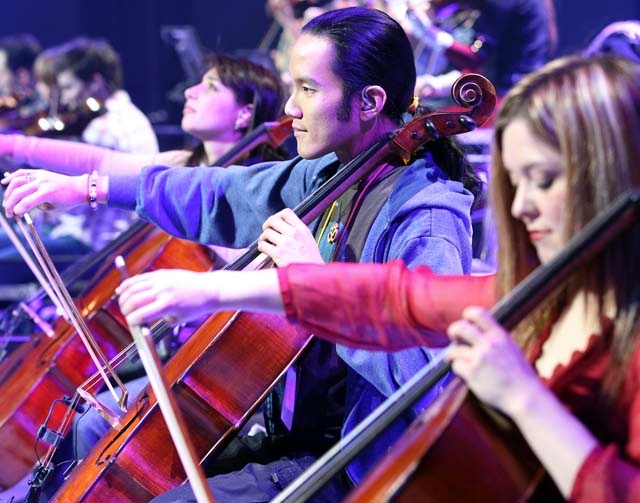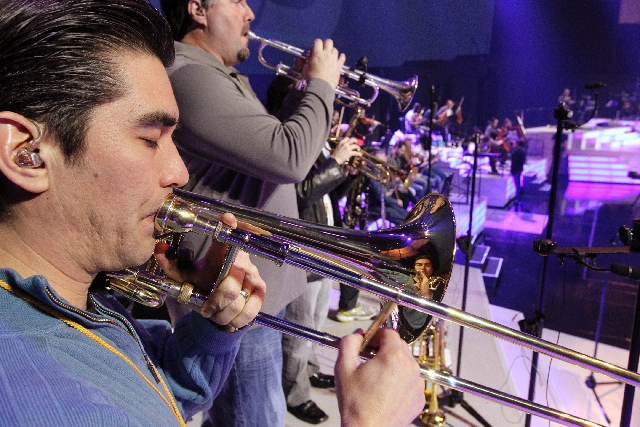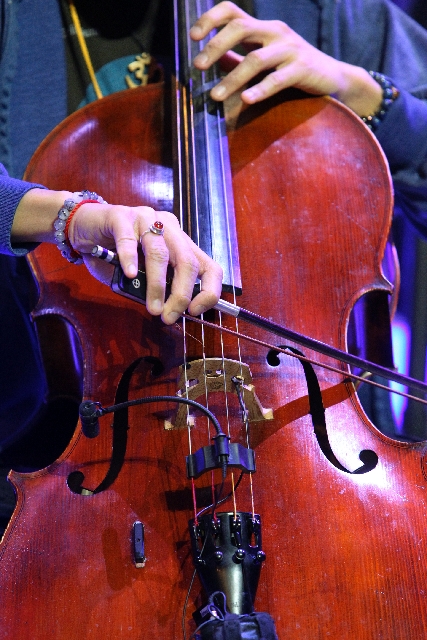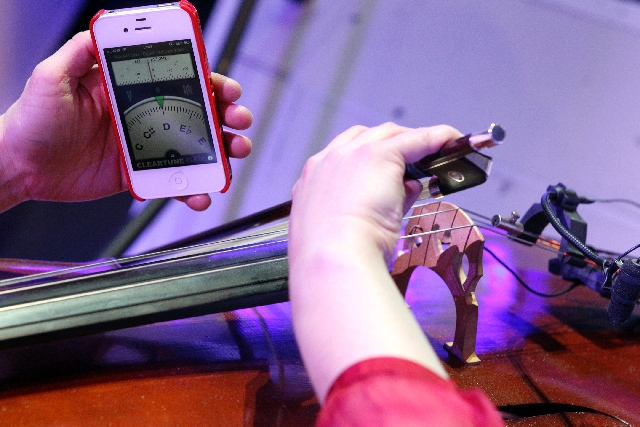Celine Dion show is springboard to opportunity for musicians
It’s a job every musician would love to have. But not every musician has the secret ingredient.
“Of course you have to be a good player. But you have to be a good person, too,” says Claude “Mego” Lemay, musical director for Celine Dion.
Lemay is a gatekeeper for the most coveted player’s job on the Strip: the singer’s Colosseum at Caesars Palace shows with a 31-piece orchestra, which bring back the good ol’ days of Las Vegas as a working musician’s paradise for at least 70 nights per year.
“It’s a really great throwback,” says lead trumpet player Dan Falcone. “It’s the first time I’ve played with an orchestra of this size since the mid- to late-’80s.”
The orchestra was hired from auditions in several cities, and many of them live elsewhere. But the Las Vegas-based contingent uses the job as a financial anchor and springboard to other opportunities — the three cellists featured on a Michael Jackson medley spinning off a side project called Cellicentric.
But the job also comes with validation that they are indeed nice people.
“It’s half the job,” Lemay says. “It’s good to be a good player, but also to be the person she is. She’s a very nice person and she’s very nice to everybody. So you don’t want to have, excuse the word, an asshole. And I auditioned a lot of assholes. You feel it very fast.”
Dion’s first Las Vegas residency, “A New Day,” gave full-time work to 50 dancers. But when the singer returned with her new show in March 2011, the windfall shifted from dancers to singers.
“We just wanted to do something different,” says Lemay, a Canadian who met the singer when she was 18 and has worked with her for 25 years. “Celine wanted to do a more classic show, more in the Frank Sinatra (vein). She wanted to bring back that flavor.”
Audiences embraced Dion’s unobstructed contact with them. And while most Las Vegas shows are brimming with dancers, it’s a near-unique experience in today’s economy to hear the opening blast of the James Bond theme “Goldfinger” played by a full orchestra.
Falcone says he grew up in the tail end of the Las Vegas that had union house bands in every casino. “I unfortunately got a nice taste of it when it ended and I’ve been longing for it ever since.”
His father is veteran arranger Vince Falcone, who worked for the likes of Frank Sinatra and Robert Goulet, so Dan was a working musician when he was in high school. By the time he finished college however, the landscape had changed. A 1989 musicians strike was unable to halt a collective move by most casino owners to end the house bands.
“There’s so little work,” says Falcone, who counts himself the exception by playing in both “Jersey Boys” and Dion’s show. “It’s getting better in a small way, but for full-time jobs for musicians on the Strip, it’s just a very small fraction of what it used to be. Especially for horn players.”
As one of the 15 ensemble members who live in Las Vegas, Lindsey Springer puts in long days balancing three jobs. She starts them as a cello instructor at K.O. Knudson Middle School, then spends a good percentage of her evenings with either Dion’s show or Frankie Moreno’s band at the Stratosphere.
“I wish it was full time,” she says of Dion’s show. But even 70 shows per year “opened up other opportunities for me.” Last month, she got to play for Carrie Underwood at the Grammy Awards (the annual broadcast is directed by Ken Ehrlich, who also put together Dion’s show).
Springer, Raymond Sicam and Irina Chirkova were teamed by chance when they arranged the Michael Jackson songs for a featured “front of curtain” number to cover a major resetting of the stage.
Kohler Co. President David Kohler enjoyed the number so much he invited the trio to perform in Wisconsin. The three wrote or arranged 90 minutes of music for that show, and Cellicentric was born, complete with an album, “Into Existence.”
“It’s nice because we spend this time together when we’re with Celine,” Sicam says. Otherwise, “living in three separate cities would be really intense for trying to keep the continuity.”
Just as Dion’s show can be an anchor gig to support new ventures, it can be an indirect subsidy for longtime local institution Santa Fe and the Fat City Horns, currently playing late-night Mondays at the Palms.
Falcone and trombonist Nathan Tanouye were recruited to help audition other members of Dion’s orchestra after Lemay came to check out Santa Fe.
“I would say the majority of gigs I’ve gotten since I joined that band in ’04 have been from people walking in and seeing (Santa Fe),” Falcone says. “It’s a great place to bring people who want to see what you do, because that band makes us play at a level that’s the very top of what we do. What it demands of musicians is as high as any job anywhere.”
The Celine Dion musicians may be gainfully employed, but they no longer just sit around. One of the show’s noteworthy touches is they way the players move around onstage and reconfigure into different combinations.
“My concern at the beginning was more that it can be very static,” Lemay says.
Now cellist Sicam is one of those who have a moment of interaction with Dion onstage, during “River Deep Mountain High.”
“I’m comfortable enough with her that if I see her standing in the wings I’ll say something to her,” says the Las Vegas Academy graduate, who now makes enough money from Dion’s show to support living in New York and commuting for her shows here.
Sicam figures he’s one of the few players who “actually used to listen to Celine when I was a kid. It was all because of ‘Beauty and the Beast.’ I don’t know how many of us were actually a fan coming into the show. When I met her I told her that,” he recalls.
And her answer?
“What happens in Vegas stays in Vegas, right?”
Contact reporter Mike Weatherford at mweatherford@
reviewjournal.com or 702-383-0288.
Preview
Celine Dion
7:30 p.m. Saturday-Sunday, Tuesday-Wednesday
Colosseum at Caesars Palace, 3570 Las Vegas Blvd. South
$55-$250 (877-423-5463)


















